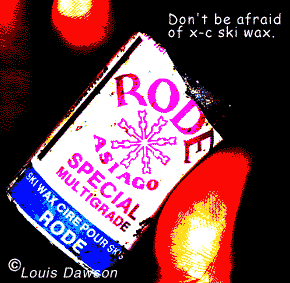
XC ski wax can be useful.
Here at WildSnow.com, we are humbled by the creativity of the backcountry glisse community. Year after year, you all keep refining tips and techniques that make ski touring safer, more fun, and more efficient. Below is a limited collection of such backcountry wisdom. About the only question these folks left me with was which credit card makes a better wax scraper, Visa or AMEX?
Bruce Edgerly from Backcountry Access had the avy beacon beta:
“Fine-tune your beeper search technique. Bury two beepers together, deep (don’t tell the searchers, of course). Watch the fun as they try to sort out the two signals. For more torture, bury one beacon in a vertical position to the side of search area. Bury another, in the horizontal position, farther down the hill in the middle of the search path. If the searchers don’t stick to proper technique they’ll blow by the vertical beeper and have to climb back up the hill to get it. To keep things fun include cookies or beer with the ‘victims’.”
Ace guide Bob Perlmutter gave me a couple of winners:
“When you’re climbing on skins, pick a point up and ahead of you, like a ridge line or summit. Concentrate on that point instead of your ski tips. By keeping your head tilted up and your shoulders back, this helps you keep your weight rearward and you’ll climb with a lot more traction and confidence.” Bob also has a trick named after him. When everyone else is fiddling with their packs, skins, gear, and whatnot, there goes Bob…you’re left standing there wondering how the guy gets so far ahead without even breathing hard. You’ve been “perled.” Bob’s secret? “I just keep all the little essentials handy so I don’t have to take my pack off to get them. I’ve got light and heavy gloves ready to change, a headband to swap for my hat when I warm up, chapstick, a sport bar — all in my pockets. I don’t over dress at the start, and I use my pit zips.”
Cell phones can be useful
Lou’s tip 1: Cell phones. Hateful or cute, they’re useful tools. If you want a lightweight phone strictly for emergencies, carry a de-activated, account-free phone (purchase a tiny flip phone off Ebay). You won’t pay a monthly charge, and you can still make a 911 or charge-card call. To make such a phone reliable, get a power cord for your car, and an AA or AAA battery pack for the trail. Bear in mind that cell phones are unreliable in the backcountry. You may not get a connection while you’re in a valley, but climb to a high-point and you often can (with the exception of vast wilderness such as Alaska or the Yukon ).
(Note that as of 2015 various backcountry emergency notification options are available, such as SPOT. But if a cell phone works it is the most effective solution as it allows easy two-way communication with authorities.)
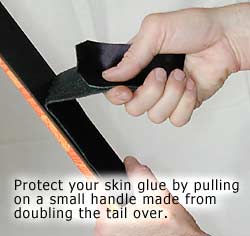
Climbing skin removal technique.
Craig Dostie gave his snowflake’s worth:
“You know how everyone thinks they need a tail hook on their skins? The reason is, each time they take off their skins, most people get their fingers all over the glue near the tail, end up contaminating it, and that’s why they need the hook. Next time you get a set of skins leave the tail hook off. Every time you remove your new skins, carefully pry up the tail section while touching the glue as little as possible. Soon as you have about 12 inches off your ski, double the tail back on itself, thus forming a handle. Now you can grab the tail of the skin and pull all you want without getting your hands on the glue. I guarantee, if you don’t contaminate your tail glue, in most cases you won’t need tail hooks.”
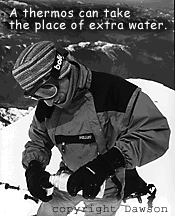
Use hot water to melt snow.
Carry a thermos
Double your water supply with no extra weight? Canadian guidebook scribe Chic Scott relates his gem of genius. “Carry a thermos filled with the hottest liquid you can make. Scoop a cup full of snow before you pour from the thermos. The hot drink melts the snow. Thus, you’ve got extra water with no extra weight. You have easily made up for the weight of your thermos — and in the morning when it’s cold you’ve got a hot drink when you need it.”
Two tips from the Ruedi
“If you’re on one of my trips, and have safety straps or cables on your bindings (instead of brakes), I’ll ask you to remove the straps for uphill travel. That way you’ve got one more thing in your favor if you get avalanched. Of course, you have to put the straps back on for each downhill run, but that extra bit of work is worth the added safety. And there is one thing I have to drill into my customers over and over: When we stop at the end of a climb, we take our skins off and switch to downhill mode before we start eating and resting, that way we’re not trying to do all that hand work after we get cold.”
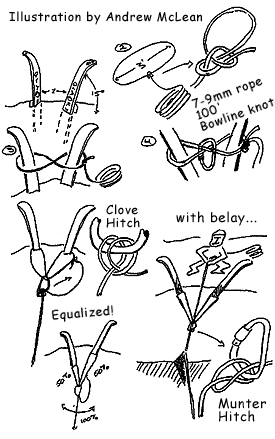
Andrew McLean tips for ski belays. Used by permission.
For a technical tip I consulted author of The Chuting Gallery, Andrew McLean:
“The self equalizing ski belay is a great way to anchor yourself when you’re digging a pit or walking to the edge of a cornice. It’s quick to set up and only requires a rope and one carabiner. The beauty of this system is that each ski only gets 50% of the load, regardless of how much you swing around on it. The drawing explains how to set it up.”
Publisher and author Brian Litz related a simple tip I’m ashamed to admit ignorance of.
“When your skin glue gets frosted or wet,” he says, “plant a ski firmly in the snow, wrap you skin around the ski with the glue towards the base, then drag the skin over an edge, back and forth, like those butt reducers they used to have in health clubs. This scrapes and squeegees off the ice and moisture, and probably warms the glue up a bit. They always stick after this treatment.”

Candy wax.
Candy bar wax job:
Not hungry but your planks are sticky? Suzy Sutphin relates a culinary treat: “My skis during my last trip didn’t have any wax, and I was picking up so much snow it was impossible to move. My friend Dan and I were racking our brains, thinking what can we put on these things so I can get home. Dan reaches into his pocket and comes out with an energy bar. We scraped the skis as best we could with a credit card, rubbed the waxy Balance bar chocolate on, and I glided home to the car in true MacGyver style!”
Lou’s tip 2:
Figure out a way to carry your shovel without the shaft sticking up like an antenna. When we do photography for Wildsnow.com, we get so tired of the “antenna shovel.” Break it down and carry inside your pack, or strap on the outside with the shaft separate from the blade. The “antenna shaft” catches on tree branches, digs in and jerks you around if you take a beater fall, and plain looks geeky.
Ski wax
Aspen area guide Scott Messina waxed enthusiastic.
“Don’t be afraid of nordic wax. Tele or randonnee AT skis, if you’re skiing a flat trail put your skins away and wax a kicker under your foot. Keep the wax thin and don’t use anything softer than extra purple. Contrary to conventional wisdom, an occasional wax job like this won’t contaminate your skins, as the wax wears off quickly while you ski (scrape and polish any residue before applying your skins). The best way to learn nordic waxing is to take a seminar from your local nordic center. You’ll be amazed how much energy you can save with this, but it only works well with colder snow, since the sticky wax you use with warm snow is tough to apply and remove and will gook up your skins.”
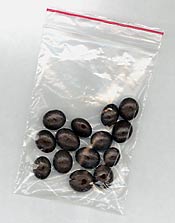
Coffee beans.
Coffee beans for backcountry skiing and snowboarding.
From Mrs. WildSnow.com: “My tip is an opportunity to indulge in every women’s dream,” says Lisa. “Something involving a man?” queries Lou with a hopeful glint. “No, dear, CHOCOLATE! I always fill my pocket with a baggy of chocolate covered espresso beans. Then, on an alpine start (read anything earlier than 7:00 AM) I munch a few while I’m starting the climb. Its a great way to get some pep, especially if you had to leave town before Starbucks opened. Don’t eat too many, or you’ll become a specimen in some biology project.”
Michael Moore told me that Starbucks is in league with Halliburton to take over the world and make us all into coffee farm slaves (the movie is coming). And then we have Subpeak, a French guide I met a few years ago, at 1:00 A.M., near the top of the famous Wall of Death at Crested Butte ski resort. According to Sub: “La haute-route du Mont Rose à skis est un “must” en matière de ski-alpinisme. Toujours au-dessus de 4000, nous traversons successivement le Breithorn, le Castor, le Naso del liskam et la Pyramide Vincent pour culminer le dernier jour à la Punta Gnifetti (4554 m), avec, la cerise sur le gateau, la superbe descente (2 700 m de denivelé) du Grenzgletscher puis du Gornergletscher jusqu’a Zermatt.”
Okay Sub, but you got any espresso beans?
(A version of this article was originally published in Couloir Magazine 12-5, March 2000)
WildSnow.com publisher emeritus and founder Lou (Louis Dawson) has a 50+ years career in climbing, backcountry skiing and ski mountaineering. He was the first person in history to ski down all 54 Colorado 14,000-foot peaks, has authored numerous books about about backcountry skiing, and has skied from the summit of Denali in Alaska, North America’s highest mountain.
